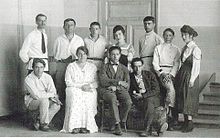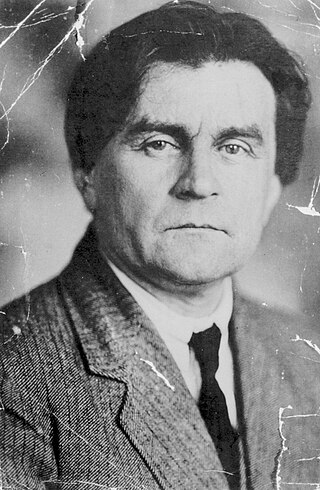
Kazimir Severinovich Malevich was a Russian avant-garde artist and art theorist, whose pioneering work and writing influenced the development of abstract art in the 20th century. He was born in Kiev, to an ethnic Polish family. His concept of Suprematism sought to develop a form of expression that moved as far as possible from the world of natural forms (objectivity) and subject matter in order to access "the supremacy of pure feeling" and spirituality. Malevich is also sometimes considered to be part of the Ukrainian avant-garde that was shaped by Ukrainian-born artists who worked first in Ukraine and later over a geographical span between Europe and America.

Suprematism is an early twentieth-century art movement focused on the fundamentals of geometry, painted in a limited range of colors. The term suprematism refers to an abstract art based upon "the supremacy of pure artistic feeling" rather than on visual depiction of objects.

The Russian avant-garde was a large, influential wave of avant-garde modern art that flourished in the Russian Empire and the Soviet Union, approximately from 1890 to 1930—although some have placed its beginning as early as 1850 and its end as late as 1960. The term covers many separate, but inextricably related, art movements that flourished at the time; including Suprematism, Constructivism, Russian Futurism, Cubo-Futurism, Zaum, Imaginism, and Neo-primitivism. In Ukraine, many of the artists who were born, grew up or were active in what is now Belarus and Ukraine, are also classified in the Ukrainian avant-garde.
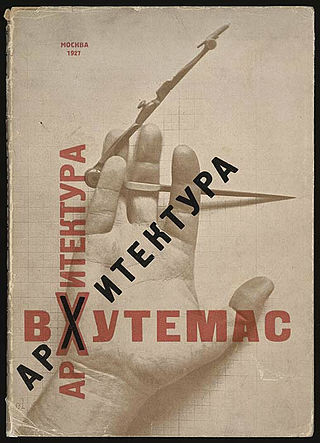
Vkhutemas was the Russian state art and technical school founded in 1920 in Moscow, replacing the Moscow Svomas.
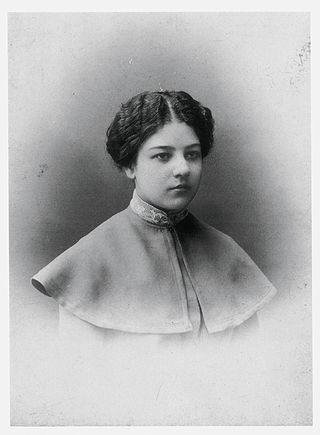
Olga Vladimirovna Rozanova was a Russian avant-garde artist painting in the styles of Suprematism, Neo-Primitivism, and Cubo-Futurism.

Productivism is an early twentieth-century art movement that is characterized by its spare geometry, limited color palette, and Cubist and Futurist influences. Aesthetically, it also looks similar to work by Kazimir Malevich and the Suprematists.
Nikolai Suetin was a Russian Suprematist artist. He worked as a graphic artist, a designer, and a ceramics painter.

Lazar Markovich Lissitzky, better known as El Lissitzky, was a Russian artist, designer, photographer, typographer, polemicist and architect. He was an important figure of the Russian avant-garde, helping develop suprematism with his mentor, Kazimir Malevich, and designing numerous exhibition displays and propaganda works for the Soviet Union. His work greatly influenced the Bauhaus and constructivist movements, and he experimented with production techniques and stylistic devices that would go on to dominate 20th-century graphic design.

Constructivist architecture was a constructivist style of modern architecture that flourished in the Soviet Union in the 1920s and early 1930s. Abstract and austere, the movement aimed to reflect modern industrial society and urban space, while rejecting decorative stylization in favor of the industrial assemblage of materials. Designs combined advanced technology and engineering with an avowedly communist social purpose. Although it was divided into several competing factions, the movement produced many pioneering projects and finished buildings, before falling out of favor around 1932. It has left marked effects on later developments in architecture.
Jānis Tilbergs, also known as Tillbergs or Tilberg ; was a Latvian artist, painter, sculptor, and medallist. He is most renowned as a highly accomplished portraitist.

Vitebsk Museum of Modern Art was an art museum in Vitebsk, Belarus organized in 1918 by Marc Chagall, Kazimir Malevich and Alexander Romm. In 1921, it exhibited 120 paintings "representing all the movements of the contemporary art from the Academic Realism to Impressionism to Suprematism". In the mid-1920s, the museum was closed. While some paintings have found their way to museums of Russia and Belarus, the whereabouts of many paintings are unknown.

Ilya Grigorevich Chashnik was a suprematist artist, a pupil of Kazimir Malevich and a founding member of the UNOVIS school.
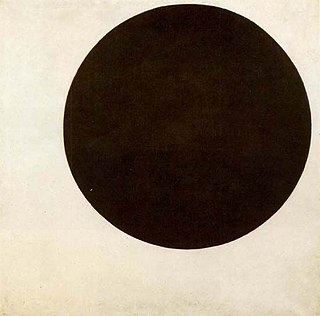
Black Circle is a 1924 oil on canvas painting by the Kiev-born Russian artist Kazimir Malevich, founder of the Russian Suprematism movement. From the mid-1910s, Malevich abandoned any trace of figurature or representation from his paintings in favour of pure abstraction.

Suprematist Composition: White on White (1918) is an abstract oil-on-canvas painting by Kazimir Malevich. It is one of the more well-known examples of the Russian Suprematism movement, painted the year after the October Revolution.

Matthew Joseph Williams Drutt is an American curator and writer who specializes in modern and contemporary art and design. Based in New York, he has owned and operated his independent consulting practice Drutt Creative Arts Management (DCAM) since 2013l. He is currently working with the Lee Ufan Foundation in Arles on an exhibition of non-objective art foor Fall 2024. More recently, he worked with the Nationalmuseum Stockholm on an exhibition and publication of modern and contemporary American crafts gifted from artists and collectors in the United States to the museum, originally organized by his mother, Helen Drutt. He has worked more recently with the Eckbo Foundation in Oslo on the first major monograph of Thorwald Hellesen published in English and Norwegian in by Arnoldsche Art Publishers. He is currently also developing several other titles with the publisher. Formerly, he worked with the Beyeler Foundation in Switzerland (2013–2016) and the State Hermitage Museum in Russia (2013–2014), consulting on exhibitions, publications, and collections. He continues to serve as an Advisory Curator to the Hermitage Museum Foundation Israel. In 2006, the French Government awarded him the Chevalier de l'Ordre des Arts et des Lettres, and in 2003, his exhibition Kazimir Malevich: Suprematism won Best Monographic Exhibition Organized Nationally from the International Association of Art Critics.
Mark Khidekel is an architect and designer.
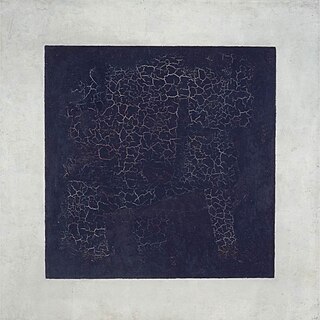
Black Square is an iconic 1915 painting by the Kyiv-born artist Kazimir Malevich. The first version was completed in 1915 and was described by the artist as his breakthrough work and the inception for the launch of his Suprematist art movement (1915–1919). In his manifesto for the Suprematist movement, Malevich said the works were intended as "desperate struggle to free art from the ballast of the objective world" by focusing only on pure form. He sought to paint works that could be understood by all, but at the same time would have an emotional impact comparable to religious works

Lazar Markovich Khidekel was an artist, designer, architect and theoretician, who is noted for realizing the abstract, avant-garde Suprematist movement through architecture.
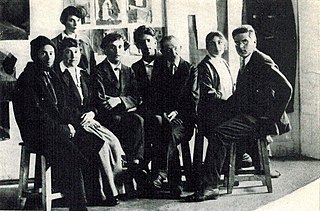
Vera Ermolaeva was a Russian painter, graphic artist and illustrator who participated in the Russian avant-garde movement.

Nina Kogan (1887–1942) was a Russian painter known for her Suprematist works.


